Archive for the 'Flowers' Category

Our alyogyne bushes are in full bloom this month. Alyogyne huegelii is a perennial evergreen bush that produces striking lavender flowers. I planted our two Mood Indigo alyogyne bushes about 5 years ago. Each spring, they are covered with pinwheel shaped flowers for about 3 months. During that time, they make a great landscape display. Although in the summer and fall, they are not especially attractive.
Alyogyne rivals the princess flower. Both plants produce large purplish flowers. The flowers of alyogyne seem to stand out more against their foliage than princess flowers, but princess flowers usually bloom over a longer period. Also, alyogyne is more cold hardy than princess flower. Alyogyne is supposed to tolerate temperatures down to about 23 degrees F. Princess flower is usually damaged below 30 degrees F.
A few years ago when the temperatures here fell into the mid 20s in January, our alyogyne bushes were undamaged, but our princess flowers died to the ground. Obviously, neither of these plants are appropriate garden choices for most of the United States and Canada (i.e., USDA zones 1-8).
April 18 2009 | Alyogyne | Comments Off on Alyogyne
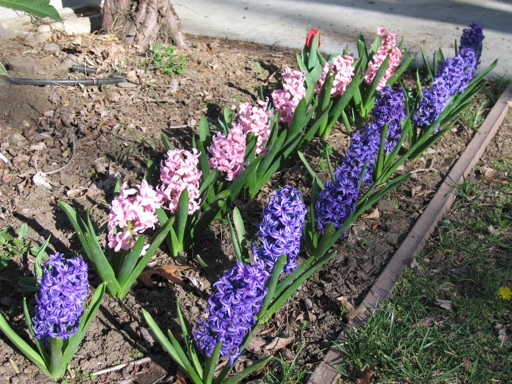
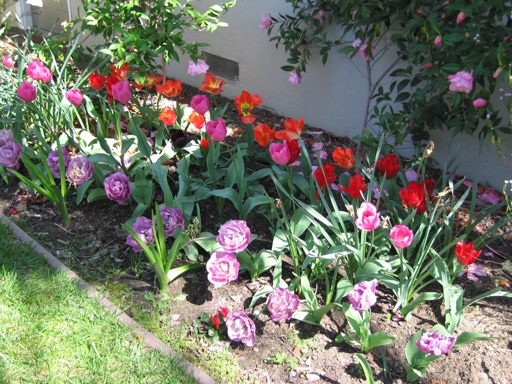
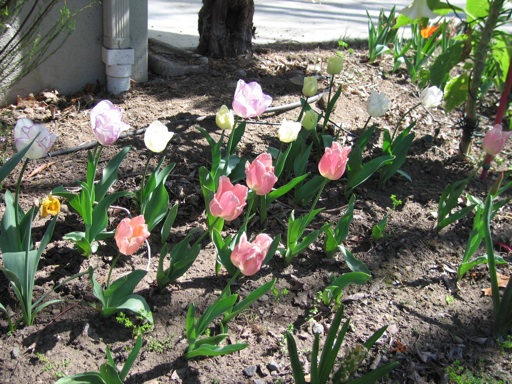
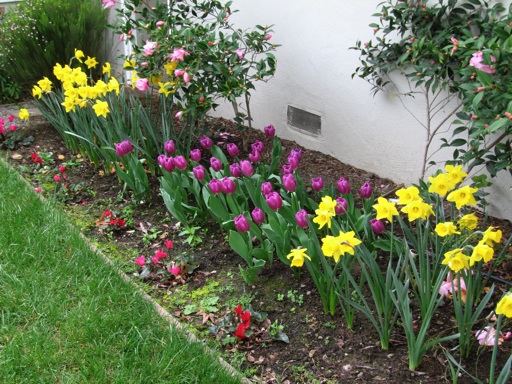
These pictures show some of the spring bulbs that have been blooming in our garden in the past few weeks. The hyacinths in the top picture were stunning at their peak about two weeks ago when I took this picture, especially the blue ones. Right now, the multicolored tulips in the second and third pictures are in full bloom.
Spring bulbs such as tulips, hyacinths, dutch irises, and daffodils are so beautiful and fun to grow. They make a wonderful landscape display for a few weeks in the springtime, because they tend to bloom at the same time and have such vibrant colors. I have gotten rave reviews from the neighbors about the color display.
Our climate doesn’t seem to get enough cold weather in the wintertime to stimulate tulips and hyacinths to continue blooming year after year. Freezes here are infrequent. Some sources say that one should dig up these bulbs and put them in the refrigerator for a month. Instead, I have been growing them as annuals, replanting them each fall and discarding some of the old ones. Our hyacinths usually bloom again more than one year, but they produce less flowers each year.
The fourth picture above showing the purple tulips and daffodils was taken in March 2008 of the same flower bed. I decided to diversify the color range of tulips I planted for this year’s display.
The same daffodils bloomed again back in February this year and have already faded away. Daffodils don’t seem to need much winter chill. They will bloom again year after year without any special care in our climate. I have seen them blooming along roads and highways in our area, obviously growing wild.
April 11 2009 | Daffodils and Hyacinths and Tulips | Comments Off on Spring Bulbs

Last summer, my sister gave us an orchid plant that she had purchased some time ago. It had flowers on it when she bought it, but it had not bloomed again in the years since then. She gave it to us to see if we could get it to bloom again.
We soaked the orchid in a water bath with orchid fertilizer every 7-14 days, along with our other orchid plant, as described in my Nov. 4, 2008 post. After about two months, her orchid began to generate a new stem of flowers. That flower stem has been growing for about six months. It is now in full bloom. All 10 of the white and pink flowers on the stem are open at the same time right now. The first flower on the stem opened over a month ago.
I don’t often see orchids being sold in stores that have many flowers on a single stem all opened at the same time and all looking so perfect. I used to think it was difficult, if not impossible, to get orchids to bloom again and again indoors. But now that we have figured out the trick, it seems easy. Our other orchid featured in my posts on Sept. 28 and Nov. 4, 2008 is already generating another flower stem.
April 11 2009 | Orchids | Comments Off on Second Hand Orchid Blooming
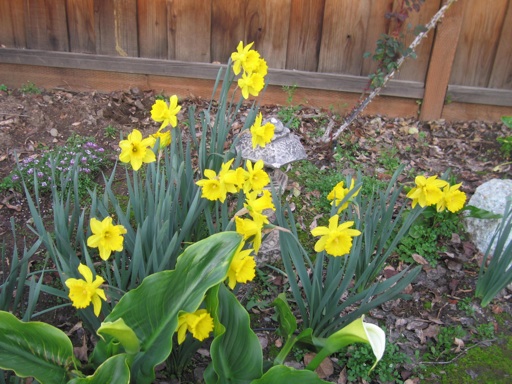
The daffodils I planted back in the fall of 2007 started to bloom again more than two weeks ago, and they are continuing to hold on to their color and shape. Daffodils are the first plants to start blooming in our yard this year. Nearly everything else is dormant. The yard looks relatively bare (see picture in my last post) so it’s nice to have some early spring color to look at.
Daffodils seem to require virtually no care in our climate. They usually get plenty of rain water in the winter as they are sprouting back to life. By the time the dry season begins in April, daffodils die back to the ground. They don’t seem to require watering while they are dormant. I didn’t water them very often last spring and summer. We received no rain from March through September, but despite the lack of rain, they came back to bloom again for a second time.
Also, daffodils don’t require a large amount of winter cold to bloom year after year like tulips and other types of spring flowering bulbs. We don’t get very much freezing weather here.
A few years ago, I made the mistake of planting daffodils under an eve of the house where they did not receive any rain water. Those daffodils grew back the next year, but they did not bloom. After a few more years, they died. I figured they died because they were not getting any water. I often see daffodils blooming alongside the freeway, so I guessed that they must be low maintenance plants. So I decided to plant more daffodils away from the house where they would receive rain. These are the daffodils in the picture.
February 28 2009 | Daffodils | Comments Off on Daffodil Blooms Signal Spring is Near

There’s not much going on in our yard right now. Most of our perennials are deciduous and are currently in their dormant phase. The only plants that are in full bloom in our yard are the camellias. This picture shows the Faith Variegated camellia bush that is blooming outside our bedroom window. Every year it fills up with pink flowers from January through March. They are beautiful flowers, although they don’t have any detectable fragrance.
Camellias tend to be a bit messy during bloom time. The flowers fall off the bush completely intact before they wilt or turn brown. They don’t fall apart petal by petal like roses. After a few weeks of blooms, the ground underneath the bush is full of pink flowers. Also, camellias don’t make great cut flowers, in my opinion, because they tend to fall off the stem in just a few days. Yet, despite the mess, they are one of my favorite garden plants, because their flowers and leaves are so attractive and eye catching.
February 07 2009 | Camellias | Comments Off on More Faith Camellias
« Prev - Next »







